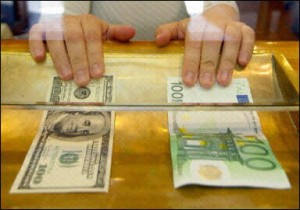 The euro could soon be doing something it’s only done a couple of times in its 16-year existence — trading 1-to-1 with the dollar.
The euro could soon be doing something it’s only done a couple of times in its 16-year existence — trading 1-to-1 with the dollar.
Europe’s single currency has since May been on a downward trajectory against the dollar, mainly because of the divergence in economic performance between the eurozone and the United States. Where the eurozone’s recovery from the global financial crisis has been at best anemic, the U.S. economy appears to be going from strength to strength.
And that divergence is hurting the euro’s fortunes.
From $1.40 last spring, it is now trading below $1.10 for the first time in 12 years and market observers think parity with the dollar could be imminent. On currency exchanges along the Champs-Elysees in Paris, it’s not far off, with one euro buying $1.039.
Beyond the symbolic value that two of the world’s biggest reserve currencies are worth the same, the euro’s decline is helping exporters in the 19 eurozone states and will make it less expensive for U.S. tourists to visit the old continent.
“The cheap euro makes Greece more attractive, and we have a very positive picture from the U.S.,” said Andreas Andreadis, head of the Association of Greek Tourist Enterprises.
The currency movements are mainly driven by the actions of each economy’s central banks. While the European Central Bank has slashed interest rates and launched a massive money-creating stimulus, effectively diluting the value of the euro, the U.S. Federal Reserve is doing the opposite — it’s preparing to raise interest rates borrowing rates following its decision last year to bring an end to its own multi-year stimulus.
The divergence has heaped pressure on the euro.
“We expect the euro will depreciate below parity in coming months,” said Tomas Holinka, economist at Moody’s Analytics.
Since its launch in 1999 at a rate of just shy of $1.18, the euro has spent most of its time above current levels.
In its early days, the euro was relatively friendless, and in late 2000, the European Central Bank, along with other central banks, including the Fed, intervened in the markets to prop up the ailing currency, which at one stage fell to a low of a little over $0.82.
That appeared to help and the euro staged a rebound, pushing back above parity with the dollar in late 2002. By the summer of 2008, just before the global financial crisis took a particularly damaging turn with the collapse of U.S. investment bank Lehman Brothers, it struck its all-time high just above $1.60.
Since last year, however, it has been on the slide again. Confirmation on Thursday from ECB President Mario Draghi that the bank is pushing ahead with its 1 trillion-euro ($1.1 trillion) stimulus program pushed the euro to its lowest in 12 years.
For the region’s exporters, who just a few months ago, were bemoaning the euro’s relative strength, that’s positive. Recent economic indicators have suggested that the euro’s decline, combined with the fall in oil prices, is helping business.
But economists cautioned against overstating the impact, particularly for the weaker, peripheral economies like Greece.
“Whether a weaker euro will help exports is debatable when for most of the periphery, trade is with other eurozone economies,” said Neil MacKinnon, global macro strategist at VTB Capital.
UT San Diego
Leave a Reply
You must be logged in to post a comment.